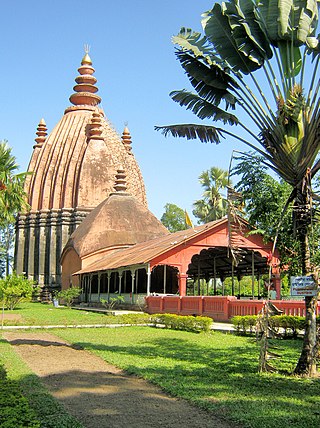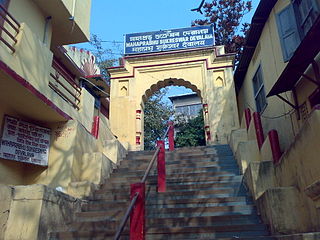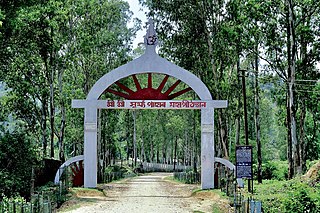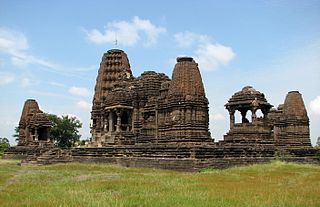
The Kamakhya Temple at Nilachal hills in Guwahati, Assam is one of the oldest and most revered centres of Tantric practices, dedicated to the goddess Kamakhya. The temple is the center of the Kulachara Tantra Marga and the site of the Ambubachi Mela, an annual festival that celebrates the menstruation of the goddess. Structurally, the temple is dated to the 8th-9th century with many subsequent rebuildings—and the final hybrid architecture defines a local style called Nilachal. It is also one among the oldest 4 of the 51 pithas in the Shakta tradition. An obscure place of worship for much of history it became an important pilgrimage destination, especially for those from Bengal, in the 19th century during colonial rule.
Navagraha (Pron: nævəˈgrɑ:ə) pilgrimages are pilgrimages devoted to Navagraha—the nine (nava) major celestial bodies (Grahas) of Hindu astronomy. These temples are made of stone. These celestial bodies are named Surya (Sun), Chandra (Moon), Mangala (Mars), Budha (Mercury), Brihaspati (Jupiter), Shukra (Venus), Shani (Saturn), Rahu and Ketu. Many temples in South India contain a shrine dedicated to the Navagrahas. However, the term Navagraha temples refers to a cluster of nine separate temples, each an abode of one of the Navagrahas.

Sivasagar district, formerly known as Sibsagar, is one of the 34 districts of Assam state in Northeast India. Sivasagar city is the administrative headquarters of this district. This historic place is also known for its rich biodiversity. The districts covers an area of 2668 square kilometers. The district comprises two sub-divisions – Sivasagar and Nazira. The district of Sivasagar lies between 26.45°N and 27.15°N latitudes and 94.25°E and 95.25°E longitudes. The district is bounded by the Brahmaputra River to the north, Nagaland to the south, the Charaideo district to the east and the Jhanji River to the west. The Sivasagar district has acquired its distinct identity due to the co-existence of different races, tribes, languages and cultures.

Hajo is a historic town set in the hills northwest of Guwahati, Assam, India. It is a meeting point of Buddhists, Hindus and Muslims due to the various pilgrimage sites on the different hills of Hajo. To the Hindus, the Manikut Parbat of Hajo is the site of the 10th-century temple ruins and the 11th- to 16th-century temples complex for Vaishnavism as well as shrines of Shaivism and Shaktism. To the Buddhists, particularly from Bhutan and Tibet, Assam is where the Buddha died and the Hayagriva temple in Hajo is a part of the sacred geography of the Buddha. To the regional Muslims, the Mughal era Poa-Mecca shrine on another hill of Hajo has the tomb of Giyasuddin Aulia built in the 17th century.

Umananda Devaloi is a Shiva temple located at the Umananda Island in the middle of river

Rangpur is the 4th capital of the Ahom kingdom, was established by Swargadeo Rudra Singha in "Meteka" in 1707 after shifting the capital from Garhgaon. It is currently a part of Sibsagar town. The place holds many monuments build by the Ahom dynasty, the most notable of which are the Talatal Ghar and the Rang Ghar.

Suremphaa, or Rajeswar Singha, the fourth son of Rudra Singha, became the king of the Ahom kingdom after the death of his brother King Pramatta Singha. Rudra Singha's third son, Mohanmala Gohain, was considered ineligible for kingship as his face was pitted with smallpox marks. According to the norm established after Sulikphaa Lora Roja, an Ahom prince had to be free from any physical disability, defects or deformities to become a king.

The Sukreswar Temple is an important Shiva temple in the state of Assam in India. The temple is located on the Sukreswar or Itakhuli hill on the south bank of river Brahmaputra in the Panbazar locality of Guwahati city. Leading down from the temple compound is a long flight of steps to the river. Sitting on the steps of Sukreswar ghat one can enjoy the scenery of sun setting on the river, boats moving across the river, people performing puja in honour of their relatives who have left this world, children and older people bathing. It has one of the largest Lingam of Lord Shiva.

Shiva dol is a group of structures comprising three Hindu temples of Sivadol, Vishnudol and Devidol shrines, and a museum. These are located on the banks of the Sivasagar tank, also known as the Borpukhuri tank, in the heart of Sivasagar, in the Indian state of Assam. The tank was constructed between 1731 and 1738 and the temples were built in 1734 by Bar Raja Ambika, queen of Ahom king Swargadeo Siva Singha (1714–1744). The height of the Sivadol is 104 feet (32 m) and the perimeter is 195 feet (59 m) at the base. It is crowned with an 8-foot (2.4 m) high golden-dome.

Sunenphaa also, Pramatta Singha, was the king of Ahom Kingdom. He succeeded his elder brother Swargadeo Siva Singha, as the king of Ahom Kingdom. His reign of seven years was peaceful and prosperous. He constructed numerous buildings and temples. The most famous of his buildings was the Rang Ghar, which is also considered as the oldest amphitheatre in Asia.

The Rudreswar Temple or Devaloya is a temple dedicated to Lord Shiva in the village of Rudreswar, under Sila Sindhurighopa Mouza, on northern bank of the river Brahmaputra, in North Guwahati. Built in 1749 CE by Ahom king Pramatta Singha, in memory of his father Swargadeo Rudra Singha, the temple is a fine example of a mixed style of Ahom-Mughal architecture.

Sutanphaa also Siva Singha was the 31st king of Assam from the Ahom dynasty who reigned from He was the eldest son of King Rudra Singha. Siva Singha was with his dying father at Guwahati, who then proceeded to the capital Rangpur where he ascended to the throne. He is noted for his elaborate system of espionage. He had numerous temples erected and made large gifts of land to them. With his patronage, Hinduism became the pre-dominant religion of the Ahoms. The king was also a patron of music and literature and music and himself composed Sanskrit songs and learnt songs. His reign coincided with the arrival of the first Europeans traders into Assam.

Sri Surya Pahar is located about 12 km southeast of Goalpara, about 132 km northwest of Guwahati, is a significant but relatively unknown archaeological site in Assam, India. Goalpara is the nearest city from the site. The site is a hilly terrain where several rock-cut Shivalingas, votive stupas and the deities of Hindu, Buddhist and Jain pantheon are scattered in an area of about one km. The site is centered on the hills (Pahar) of Sri Surya which is profusely filled up with Shiva Lingas (Lingam). People have found 99999 Shiva Lingas were engraved here by Vyasa in order to build up a second Kashi and once it was one of the holiest pilgrimage sites in the region. There is no historical evidence exactly how many Lingams once dotted in these hills, but still there are hundreds of them, from tiny to large in size, scattered everywhere at the foot of the hill and covering the extensive area after centuries of neglect and pilferage. The exact figure of the Lingas in the hill is yet to be counted scientifically.

Dirgheswari Mandir is a temple situated in the northern banks of the river Brahmaputra in North Guwahati, Assam, India. Many ancient images made on rocks existed along with the temple. Brick temple was Built by Ahom king Swargadeo Siva Singha, Dirgheswari temple is considered as a Shakti Peetha for Shakti Worship. The main attraction of Dirgheswari temple is the annual Durga Puja celebrations, in which devotees from far of places use to attend.

The Siddhivinayak Temple of Siddhatek is a Hindu temple dedicated to Ganesha, the elephant-headed god of wisdom. The temple is one of the Ashtavinayaka, the eight revered shrines of Ganesha in the Indian state of Maharashtra and the only Ashtavinayaka shrine in Ahmednagar district.
Assam – 16th largest, 15th most populous and 26th most literate state of the 28 states of the democratic Republic of India. Assam is at 14th position in life expectancy and 8th in female-to-male sex ratio. Assam is the 21st most media exposed states in India. The Economy of Assam is largely agriculture based with 69% of the population engaged in it. Growth rate of Assam's income has not kept pace with that of India's during the Post-British Era; differences increased rapidly since the 1970s. While the Indian economy grew at 6 percent per annum over the period of 1981 to 2000, the same of Assam's grew only by 3.3 percent.

The Gondeshwar Temple is an 11th-12th century Hindu temple located in Sinnar, a town in the Nashik district of Maharashtra, India. It features a panchayatana plan; with a main shrine dedicated to Shiva; and four subsidiary shrines dedicated to Surya, Vishnu, Parvati, and Ganesha.
Phuleswari, also known as Pramateswari Devi, was the chief consort of an Ahom king Siva Singha of Ahom kingdom of what is now Assam who ruled the kingdom from 1722 to 1731 A.D. She was the first queen of Ahom kingdom to govern the kingdom directly. She was originally a dancer in a religious temple dedicated to the Hindu God Shiva. When the king saw her, he was captivated by her beauty and decided to marry her and made her his chief consort. Phuleswari after having assumed the title of Bor Raja, coins were minted on her, alongside her husband.

The Keshavnarayan Vishnu dol, popularly known as Joy dol, was constructed in 1698 by Ahom king Swargadeo Rudra Singha (1696–1714) in honour and memory of his mother Joymoti. Particularly this temple is dedicated to Hindu god Lord Vishnu. The presiding deity of the temple was before known as Kesavaraya Visnu This temple is constructed of brick and stone. The walls are decorated with images of celestial beings and sculptures representing the social life of the day such as the sports and favourite pastimes of the erstwhile Ahom kings. The Joysagar Group of temples standing on the banks of the tank of the same name includes the Joydol, the Sivadol, the Devi Ghar, and the Ghanashyam House.

Raidongia Doul or Raidongia Dol is a historical doul located in the Lejai-Kalakhowa area of Dibrugarh district. It was built in 1750 by the Ahom king Swargadeo Pramatta Singha (1744–1751). Initially it was a Devi Temple. Over time, a house was built near the doul and the people of the area started to worship Shiva. Therefore, the present doul is also known as Shiv Doul or Raidongia Shiv Doul. Its main festival is Maha Shivratri. The Archaeological Department of the Government of Assam has recognized the Raidongia Doul as a State Protected Monument.























